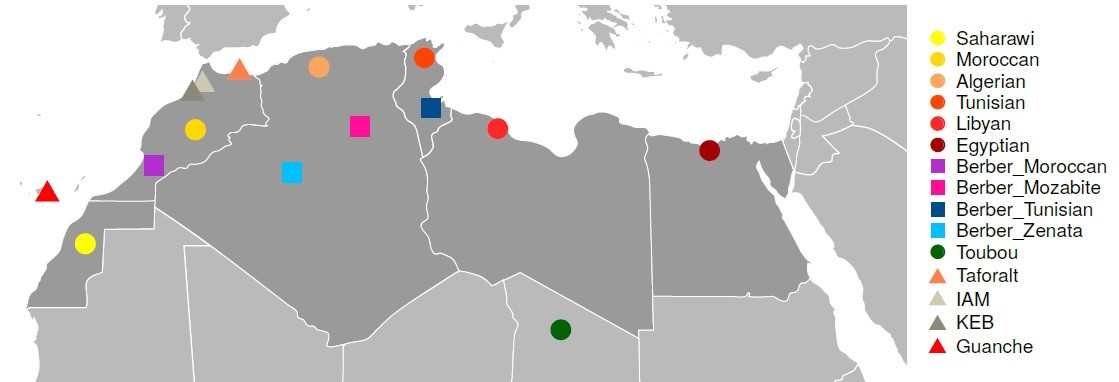Detecten l’empremta genètica de les poblacions paleolítiques a les poblacions nord-africanes actuals
La ciència està plena de SHEroes que amb la seva passió, treball i creativitat han inspirat la biologia evolutiva d'avui.
Com a part del nostre compromís amb la societat, l'Institut de Biologia Evolutiva (IBE, CSIC-UPF) vol donar crèdit i visibilitat als assoliments de les científiques en evolució.
Amb aquest objectiu, llancem la campanya #WhoisyourSHEro per a compartir històries de dones que han tingut un impacte en la carrera científica dels / les nostres investigadors/es a través de les xarxes socials i la web.
La campanya continua avançant a mesura que més i més dones en evolució inspiren a la comunitat IBE.
Pots unir-te a la conversa a través de les xarxes socials amb l'etiqueta #WhoisyourSHEro.
 |
Detecten l’empremta genètica de les poblacions paleolítiques a les poblacions nord-africanes actuals
Detecten l’empremta genètica de les poblacions paleolítiques a les poblacions nord-africanes actuals
Un equip internacional de científics ha fet per primera vegada una anàlisi a nivell de genoma complet de la població del nord d’Àfrica. Han detectat una petita empremta genètica dels pobladors de la regió en temps paleolítics, per tant descarten que les migracions recent d’altres regions esborressin completament el rastre genètic dels antics nord africans. El treball ha estat liderat per David Comas, investigador principal a la UPF i a l’Institut de Biologia Evolutiva (IBE: CSIC-UPF) i s'ha publicat a la revista Current Biology.
En els últims anys s’ha produït un gran desenvolupament de la genòmica, la seqüenciació de l’ADN és cada vegada més assequible i existeixen grans projectes d’estudi dels genomes a nivell poblacional. Tot i així, hi ha poblacions humanes com les del nord d’Àfrica que han estat sistemàticament ignorades. Aquest ha estat el primer estudi genòmic que posa en context aquesta regió del món.
Han comparat dades genètiques d’individus nord-africans actuals amb dades recentment publicades d’ADN de restes fòssils de diferents jaciments del Marroc.
El nord d’Àfrica ha tingut un origen i una història poblacional diferent a la resta del continent i molt més similar a la història demogràfica de fora d’Àfrica: l’Orient Mitjà, Europa o Àsia. Hi ha restes paleontològiques que demostren l’existència d’humans a la regió fa més de 300.000 anys. No obstant, estudis genètics previs havien demostrat que les poblacions actuals del nord d’Àfrica provenen d’un back to Africa, és a dir, de migracions recents que des d’Orient Mitjà van poblar el nord del continent africà.
Per això el debat que es planteja és el de continuïtat versus reemplaçament. D’una banda, la hipòtesi de la continuïtat diu que les poblacions nord-africanes actuals descendeixen de grups paleolítics, és a dir, que aquells humans tan antics són els antecessors de les poblacions humanes actuals. D’altra banda, altres hipòtesis plantegen que hi va haver un reemplaçament d’aquestes poblacions existents en temps paleolítics, i que els humans que hi ha actualment al nord d’Àfrica són resultat de migracions més recents que van arribar allà posteriorment, a partir de l’època neolítica.

En aquest estudi els investigadors han comparat dades genètiques d’individus nord-africans actuals amb dades recentment publicades d’ADN de restes fòssils de diferents jaciments del Marroc. “Veiem que les poblacions actuals del nord d’Àfrica són resultat d’aquest reemplaçament però detectem petites traces de continuïtat des de temps paleolítics, és a dir, que el reemplaçament no va ser total a les poblacions del nord d’Àfrica”, detalla David Comas, catedràtic d’Antropologia Biològica del Departament de Ciències Experimentals i de la Salut (DCEXS) de la UPF. “No sabem si els primers pobladors de fa 300.000 anys són els avantpassats però sí que podem detectar empremtes d’aquesta continuïtat com a mínim des de temps paleolítics, almenys des de fa 15.000 anys”, afegeix.
“Hem vist que l'empremta genètica de les poblacions paleolítiques del nord d'Àfrica és exclusiva de les actuals poblacions nord-africanes i que està distribuïda de manera decreixent d'oest a est de la regió, de manera inversament proporcional a la component neolítica procedent d'Orient Mitjà, que va afectar més la regió de l’est, més propera geogràficament.”, diu Gerard Serra-Vidal, primer autor de l’article.
Migracions d’altres regions com Europa, Orient Mitjà o l’Àfrica subsahariana cap a aquesta àrea no van esborrar completament el rastre genètic dels antics nord africans.
“Per tant, els nostres resultats confirmen que migracions d’altres regions com Europa, Orient Mitjà o l’Àfrica subsahariana cap a aquesta àrea no van esborrar completament el rastre genètic dels antics nord africans”, explica David Comas, cap del grup de Diversitat del Genoma Humà de l’IBE.
Aquests resultats de les poblacions del Nord d’Àfrica contrasten amb el que es coneix del continent europeu, on les poblacions europees actuals mostren un fort component paleolític, és a dir, més continuïtat i menys reemplaçament que al Nord d’Àfrica.
Encara manquen moltes dades genòmiques, tant de poblacions actuals com de restes fòssils, per a establir la història poblacional de l’espècie humana. “Aquest fet és especialment preocupant en poblacions com les del Nord d’Àfrica de les quals en tenim molt poca informació en comparació amb altres poblacions del planeta. Per tal de disposar d’un panorama complet de la diversitat genòmica humana encara hem de fer un esforç de recerca considerable”, conclou David Comas.
A l’estudi han participat investigadors de la Universitat de Taibah (Aràbia Saudita), la Universitat de Tunis El Manar (Tunísia), la Universitat d’Oran (Algèria) i la Universitat Libanesa Americana (el Líban).
Article de referència:
Serra-Vidal et al., Heterogeneity in Palaeolithic Population Continuity and Neolithic Expansion in North Africa, Current Biology (2019), https://doi.org/10.1016/j.cub.2019.09.050.
